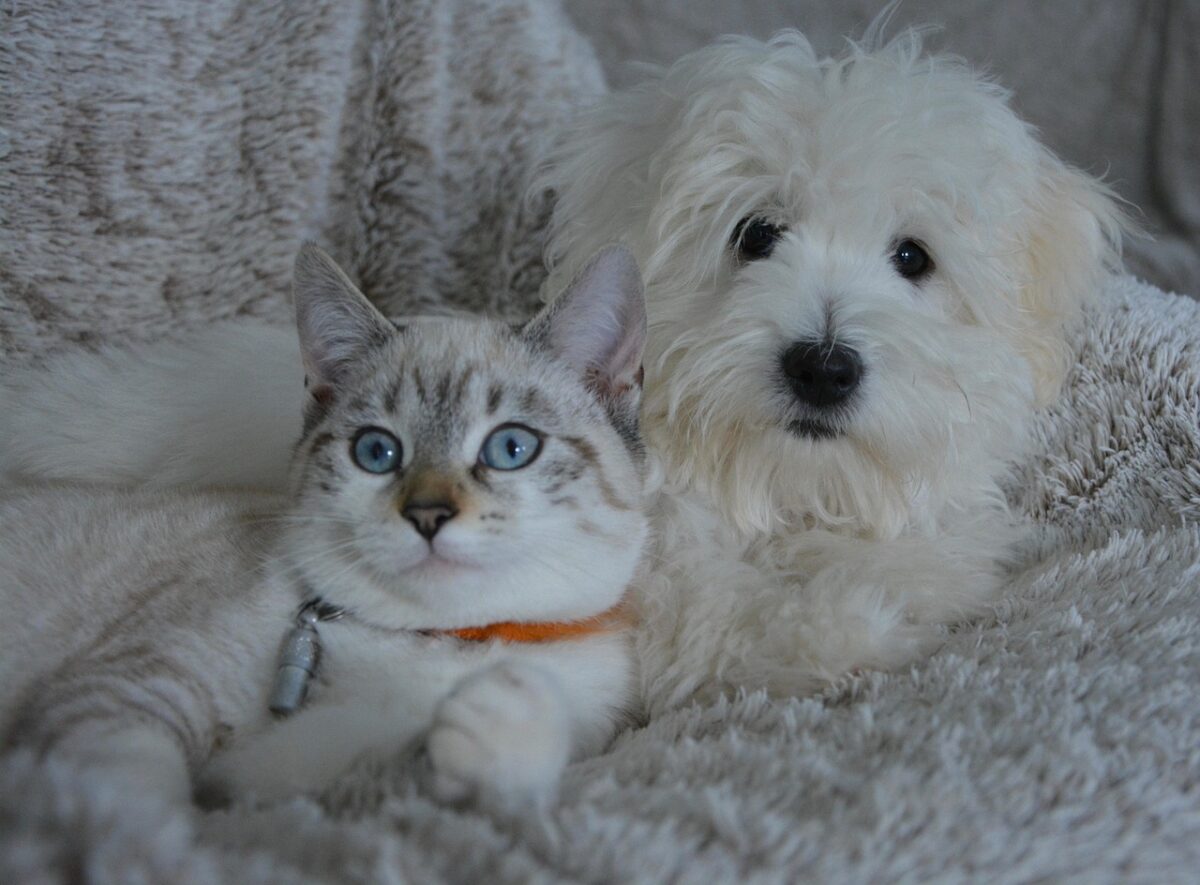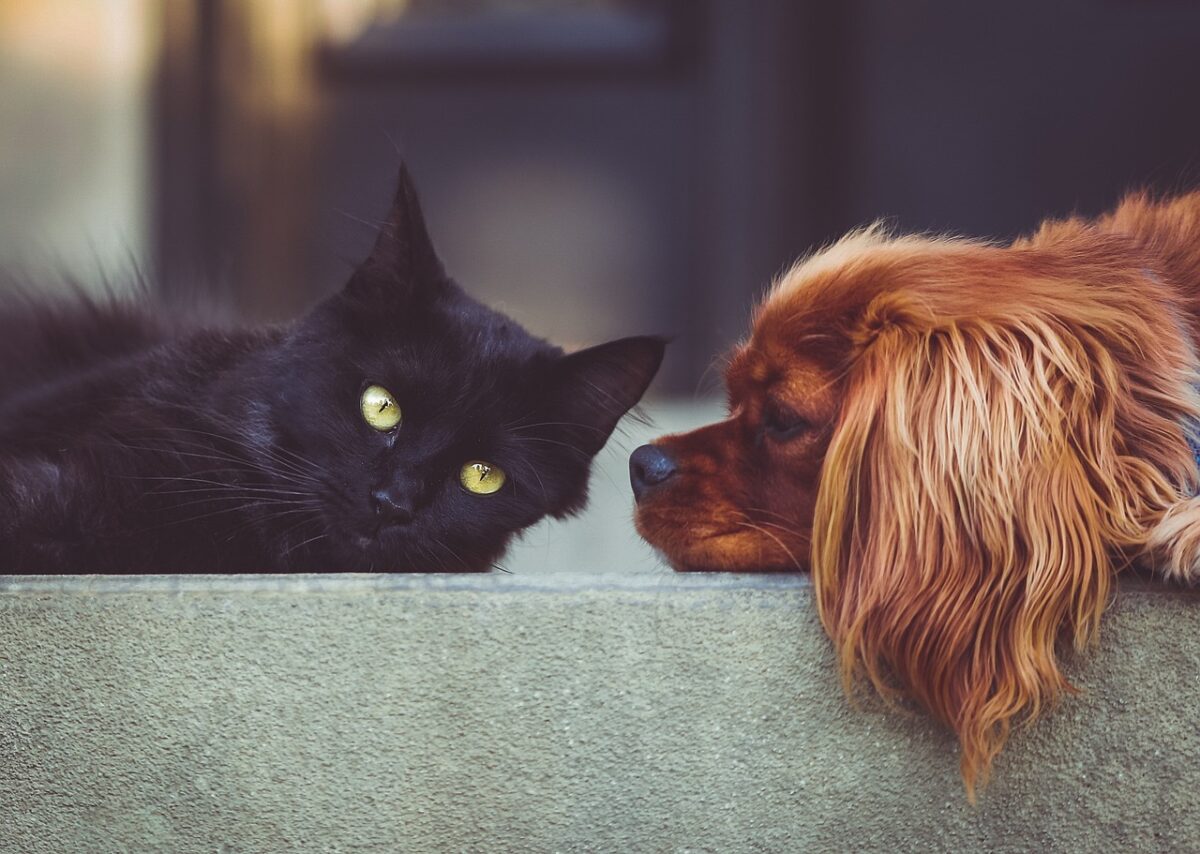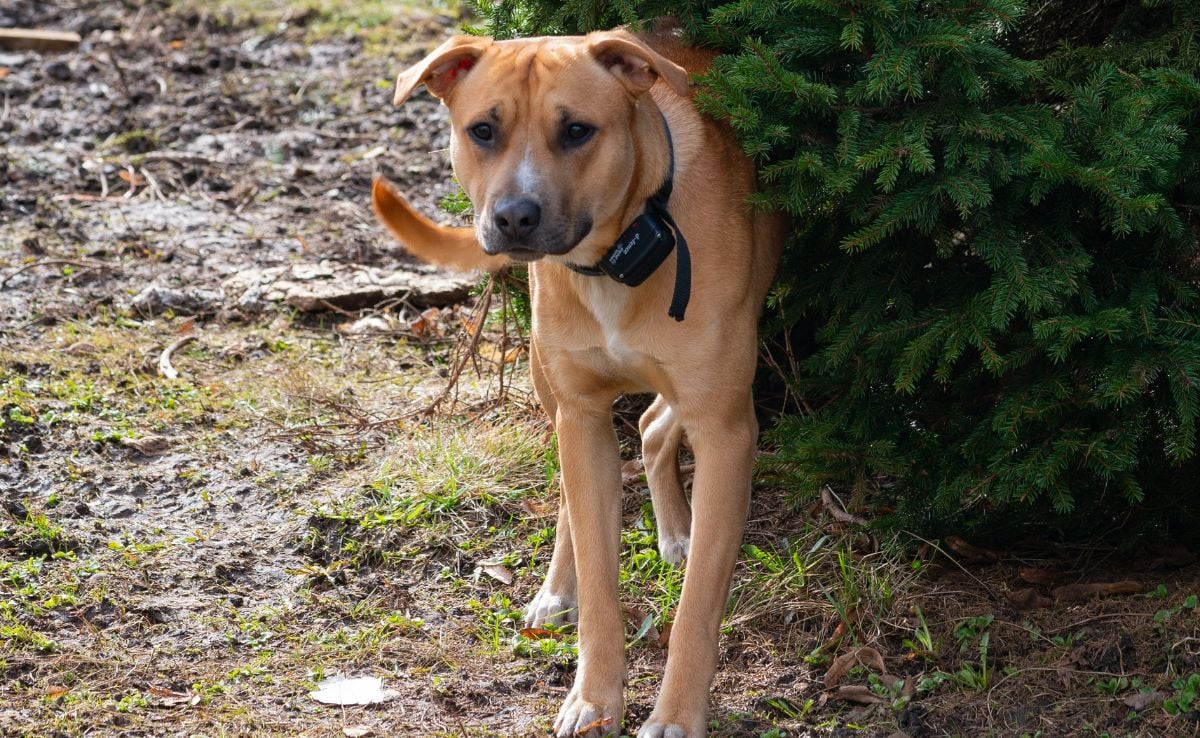Introducing Dog to Cat: How To Turn First Meetings Into Lifelong Friendships
When you purchase through links on our site, we may earn a commission. Here’s how it works.
You dreamed of the perfect pet duo: your dog and cat curled up together, purring and snoozing like a Disney movie come to life. Instead? You’re frantically searching “introducing dog to cat” as your cat hisses from the bookshelf and your dog looks heartbroken on the floor.
Table of Contents
Introducing a dog to a cat isn’t just a one-time meet-and-greet; in reality, it’s a delicate dance of patience, trust, and small wins. Rushing it can lead to fear, fights, or long-term tension.
But when you take it step by step, you’re not just preventing chaos; you’re laying the foundation for something amazing: a peaceful, happy home where paws and tails coexist, and maybe even where lifelong friendships are born.

Whether you’re blending a bouncy puppy with a wary cat or bringing home a tiny kitten to meet your loyal hound, we’ll help you navigate the ups, the downs, and all the tail-wagging moments in between.
Do Cats and Dogs Get Along? A Real-World Answer
It is one of the most common and most nerve-wracking questions pet owners ask:
“Can my cat and dog actually get along?”
The honest answer: It depends. Not just on the animals, but on you, their environment, how you handle introductions, and the time and patience you are willing to invest.
Expect Disruption and Be Ready For It
Bringing a new pet into your home is exciting for you, but for your animals, it is a total life shake-up.
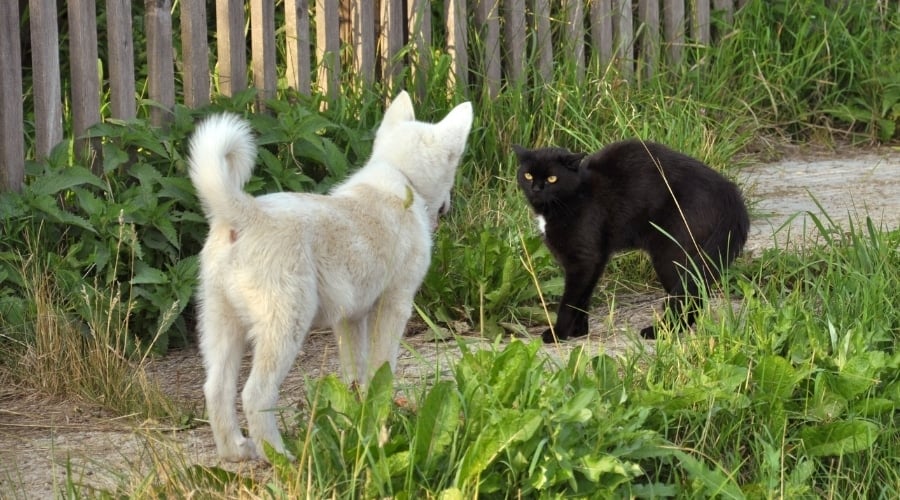
Dogs can be confused and need reassurance. A new cat or kitten will be scared, unsure, and need to feel safe. Introducing a cat to a dog is a delicate process that owners must prepare for in advance. It is essential to ensure that your dog and other established pets do not feel displaced.
- Your dog may feel confused, anxious, or territorial.
- A new cat or kitten will likely be scared, unsure, and desperate for a sense of safety.
Introducing a cat to a dog (or vice versa) is not something you wing. It is a process you prepare for ahead of time.
Age Matters A Lot
The age combinations change everything.
- Kitten with Dog: Kittens are tiny, vulnerable, and easily injured. You will need extra caution.
- Adult Cat with Dog: Adult cats may stand their ground, but they can also lash out or hide.
- Puppy with Cat: Puppies are excitable and often clueless about feline boundaries.
- Puppy with Kitten: Double chaos — adorable, but high-maintenance.
Tip: Set up separate spaces, with their own food bowls, water, toys, beds, and litter box. Sharing can come later, once trust is built.
The Most Crucial Step: Meet Before Adoption
Whenever possible, introduce the new pet to your current pets before finalizing the adoption.

Watch how they react. Is it cautious curiosity? Total panic? Growling or lunging? Even if they do not become instant best friends, you want to see at least a willingness to tolerate each other.
Warning sign: An immediate aggressive or fearful reaction may be a sign to reconsider or delay adding a new pet.
Big Picture: Patience Over Perfection
Remember, you are not just mixing animals. You are building a new family dynamic. They do not have to be snuggling on day one. What matters is that everyone feels safe, respected, and not displaced.
Age Matters: Why It Changes Everything
When introducing a cat and a dog, age is more than just a number; it significantly influences how they interact, play, and establish trust. A tiny kitten and an adult dog will need a very different approach than a puppy meeting a senior cat. Understanding these age dynamics is key to setting up a safe, successful introduction for both pets.
Introducing a Kitten to a Dog
Introducing a kitten to a dog can be one of the most heart-melting and nerve-wracking experiences for any pet owner. On one hand, you picture adorable snuggles and nose boops. On the other hand, you worry your playful dog might treat the kitten like a squeaky toy.
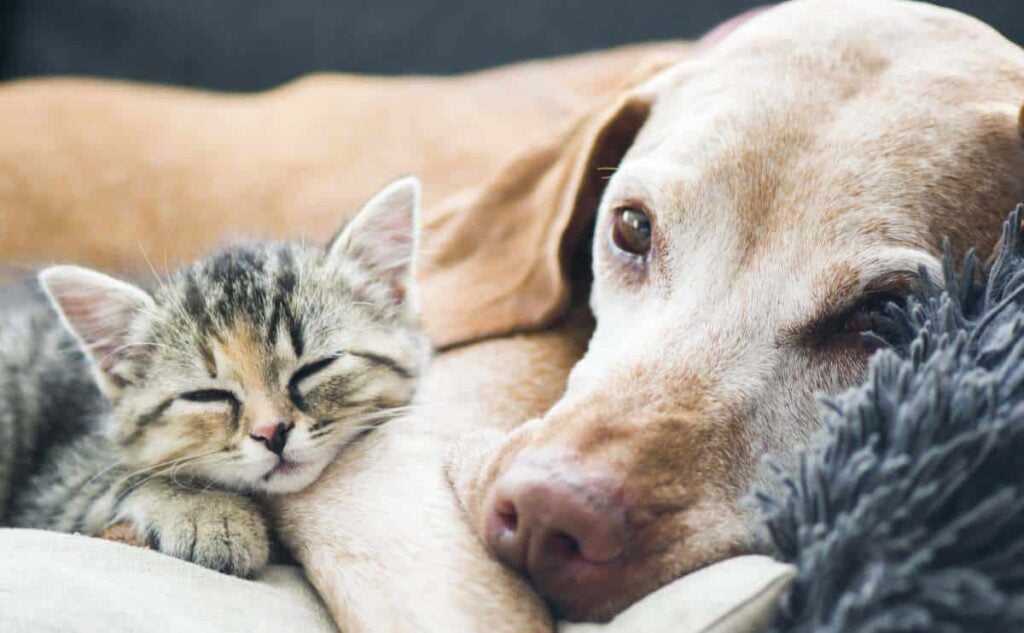
- Kittens are delicate, fast-moving, and can easily get hurt. For that reason, it is often safer if the dog is a little older, past the roughhousing puppy stage, and has already learned basic obedience commands like “leave it” and “gentle.”
- Supervision is non-negotiable. Never leave a kitten alone with a dog until you are completely confident they can safely interact.
- If possible, arrange introductions in a neutral space, somewhere the dog will not feel territorial, like a friend’s fenced yard or an unfamiliar room. This helps reduce protective instincts and sets the stage for a calmer meeting.
Introducing a Puppy to a Cat
Now flip the script: introducing a puppy to a cat. Puppies are naturally excitable, bouncy, and often clueless about feline boundaries. A younger, playful cat might tolerate or even enjoy this energy, but an older or more reserved cat may find it overwhelming or stressful.
If you are pairing a puppy with a senior cat, be extra cautious. Elderly cats have fragile bodies and less patience for chaos. In these cases, it is often better to choose a dog breed known for calmness or wait until the puppy matures a bit before encouraging close interaction.
Know Your Pets, Not Just Their Stereotypes
At the end of the day, you know your animals best. Not all puppies are hyper, and not all kittens are timid. Some cats are surprisingly dog-like in their playfulness, while some dogs are couch potatoes from day one.
The key is to tune into your pets’ unique personalities and prepare the environment and introductions accordingly. With patience, preparation, and a lot of love, you can help build a home where paws, purrs, and wagging tails all live happily under the same roof.
Pet History and Breed Considerations
Before you bring a new cat or dog into your home, take a moment to think about their background. Past experiences can make all the difference in how smoothly they adjust to a new furry roommate.
If you already have a dog, it’s smart to adopt a cat that has been around dogs before. A cat with no dog experience may be more fearful or defensive. The same goes the other way — if you have a cat, look for a dog that has lived with or been around cats.
Here’s what to check before you adopt:
- For your existing pet:
- Does your dog have a history of being gentle around cats?
- Does your cat stay calm or curious when seeing dogs?
- For the pet you want to adopt:
- Has the cat been exposed to dogs?
- Has the dog lived with cats or shown signs of being cat-friendly?
- For both:
- Avoid high-prey-drive dog breeds if you have a cat.
- Avoid adopting a cat known to be fearful or aggressive toward dogs.
When adopting, always ask the shelter, rescue, or breeder about the animal’s past experiences. Adopting a cat who panics at the sight of dogs or a dog who sees cats as something to chase is setting yourself up for stress and potential danger.
Bottom line: Match not just species, but personalities and past experiences to give your pets the best chance at a happy, peaceful home.
Let Each Animal Settle In Separately
When you bring your new animal home, it’s best to provide separate living quarters for them initially. For example, if you’re adopting a new cat, you may want to place their food, water, and litter box in the same room and close it off so the dog cannot access them.
Choose a room that is comfortable, such as a bedroom, rather than a closet or another dark space. This allows your cat time to settle in and start feeling comfortable in its new home.
As the animals settle in, they’ll probably take notice of the other. They may hear a meow or loud footsteps on the hardwood floors. They will recognize these sounds and notice that there’s another animal in the home.
5 Simple Steps for Introducing Cats and Dogs
Introducing a cat and a dog takes patience, planning, and understanding. Follow these five key steps to help set them up for success.
1. Familiarize Each Other’s Scents
Before they ever meet, let your cat and dog get used to each other’s smell. Swap blankets, towels, beds, or toys between their spaces. This helps lower their curiosity or anxiety when they finally see each other.
Allow the pets to explore the other blanket or towel as they wish; do not force them to do anything. You’ll need to do this every day because the scent will wear off.
2. Make the Introduction Through Glass or a Barrier
Use a baby gate, screen door, or glass door to let them see each other without physical contact. Watch their body language: calm curiosity is a good sign, while growling, hissing, or lunging means they need more time apart.
Is the cat’s back arched? Is the dog barking excessively? These are warning signs that the animals are not ready to meet face-to-face. Repeat this introduction through the glass until each animal is calm when seeing the other.
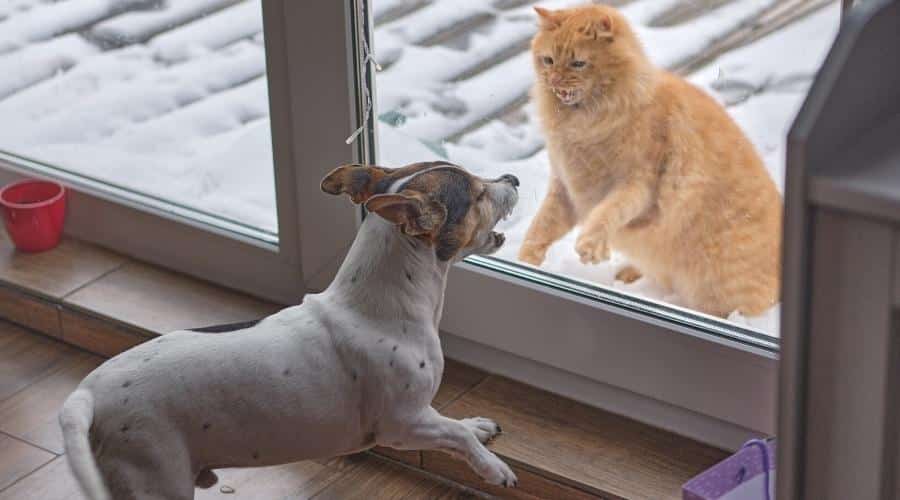
You do not want to force either one to do anything. If possible, have another person help you, so you can have someone with each animal. Each of you can give treats to the dog and cat near the glass door to show that being around the other is a good thing.
3. Use Barriers for Short, Controlled Meetings
Start with brief sessions where they are in the same room but separated by a dog gate or crate. Keep sessions short, positive, and always supervised.
Keep in mind that cats can jump over gates and squeeze through small openings, so you’ll want to monitor them. Repeat this and give treats until both animals seem calm around one another.
4. Face-to-face Meeting
Now comes the big moment… the first face-to-face meeting.
- Start with your dog on a leash.
Let both pets be in the same room. Do not force interaction — let the cat approach if and when they feel ready. - Allow your cat to move freely.
If your cat wants to hide at first, that is completely normal. To help them feel safer, try offering treats while they remain in the dog’s sight. - Keep sessions short and calm.
Watch for signs of stress or excitement. Reward your dog for staying calm with treats and praise. - Gradually extend the leash.
Give your dog a little more room to sniff and explore, but always maintain control. After a few seconds, call them back and reward them for listening. - Work toward off-leash time (with supervision).
Only once both pets have had many positive interactions should you consider off-leash time. Supervise all interactions until at least a month has passed with no bad incidents.
Remember: The goal is trust, not speed. Go at your pets’ pace and make sure they feel safe every step of the way.
Ready to see all these steps in action? Watch this adorable video of a dog meeting a kitten for the first time, proof that with patience and the right approach, even the most unlikely friendships can begin with a wag and a purr.
5. Positive Reinforcement and Calm Behavior
Reward both pets with treats, praise, and calm attention when they behave well around each other. This helps them associate the other animal with good things, not stress or punishment.
Once both pets stay calm during controlled meetings, allow short, supervised interactions without barriers. Keep the dog on a leash at first. Gradually increase their freedom over days or weeks, always watching for signs of stress or aggression.
Remember: Some pets click right away, and others take weeks or even months to adjust. Go at their pace, not yours.
Personal Experience: Our Team Shares Their Cat and Dog Introduction Stories
Introducing a cat and a dog isn’t always easy, but it’s almost always unforgettable. Our team has been through the nerves, the surprises, and the sweet moments that come with blending furry families. In this section, we share some of our favorite real-life cat and dog introduction stories, the lessons we learned along the way, and why all the effort is so worth it.
Tiny and Monk: A Gentle Cat and Dog Introduction Story
Here’s how one of our team members introduced a new kitten, Monk, to their dog, Tiny, and what surprised them most about the process
When I first brought my new kitten, Monk, home, I was a little nervous about how he’d get along with my dog, Tiny. Tiny was already used to two adult cats I have indoors, but he had never experienced a kitten before. And I wasn’t sure how Monk would react to a dog (let alone two other cats!).
I set up a quiet room just for Monk. For the first few days, I let them sniff each other under the door. On day three, I let them see each other through a baby gate. Monk was full of curiosity and wanted to play. Tiny just wagged his tail and walked away.
It took a whole week before I let them meet face-to-face. I kept Tiny on a leash and let Monk approach him. There was a lot of staring and sniffing, but no aggression. Monk quickly picked up on how to interact with Tiny from my other two cats. He’s pretty ambivalent about the cats, so Monk wasn’t over the top with him (like kittens can be). Now they all live in harmony, except for the occasional kitten versus cat issues.
– Sally Jones, Cat & Dog Mom, Canine Journal Writer & Editor
Luna, Lucy, and Rio: A Slow and Rewarding Cat and Dog Introduction
This is the story of how Luna and Lucy, two confident house cats, met Rio, a sweet but clumsy Golden Retriever, and how their family navigated the ups and downs of bringing them all together
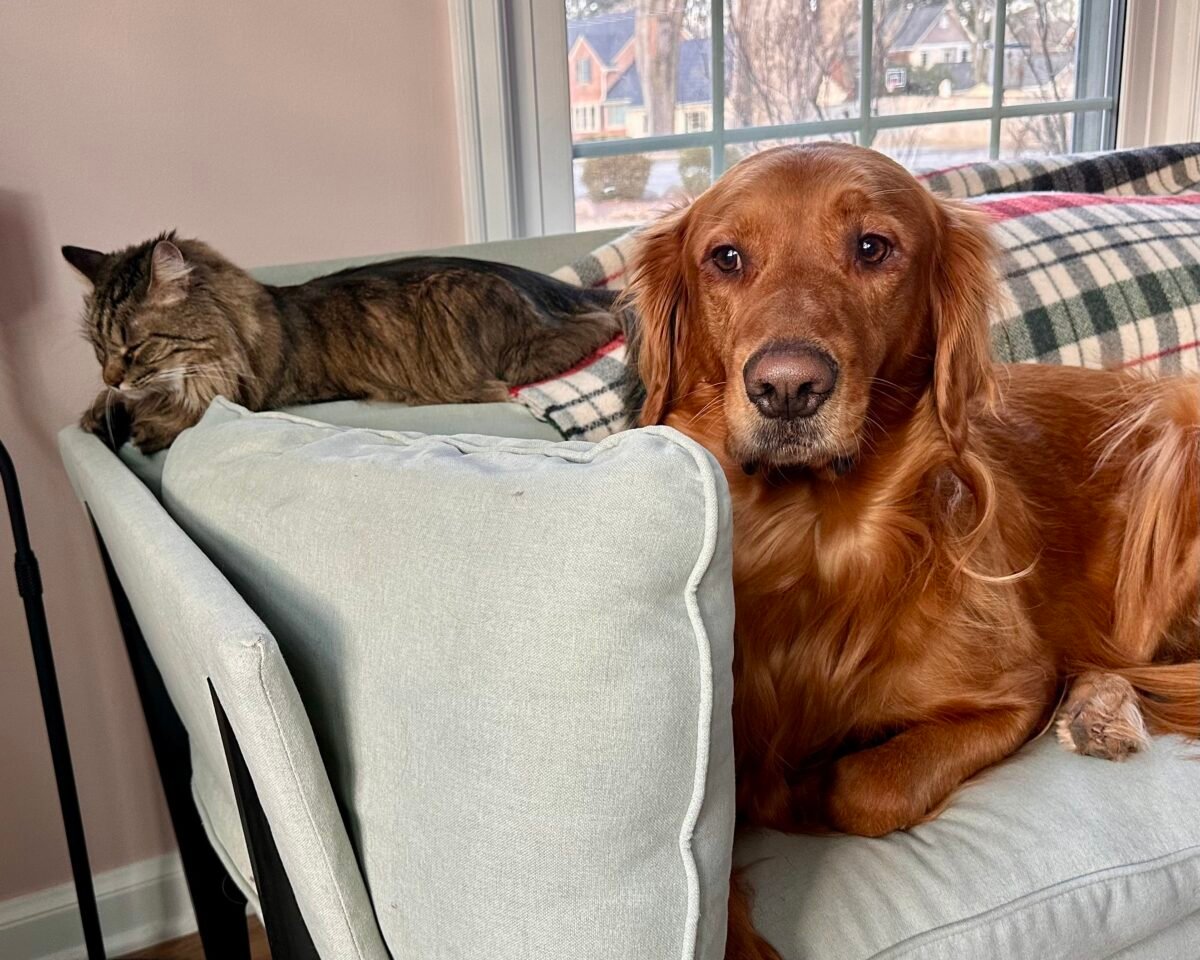
My two cats, Luna and Lucy, were the only pets in the house for years. They’re confident, curious, and very used to having the place to themselves. That changed earlier this year when we adopted Rio, a sweet and slightly clumsy Golden Retriever.
Before making things official, I arranged an introduction. Rio had never lived with cats, so I wanted to ensure he wouldn’t be aggressive or overly physical. Thankfully, he stayed calm and respectful during that first meeting—a promising start.
For the initial intro, we kept the cats in their carriers. Those carriers are familiar, comforting spaces for them, and they provided a safe way for Rio to check them out without any chaos.
After a few cautious sniffs, we opened the doors and let the cats decide if they wanted to stay inside or explore. There was plenty of hissing and hiding, but they didn’t flee the room. That alone felt like a win.
They were curious—just from a distance. After that, we never forced interactions. When Rio moved in, we set up a baby gate with a cat-sized door, allowing Luna and Lucy to access their own space at any time.
We reinforced every calm interaction with treats and lots of praise. They’re not exactly snuggling all day, but they’ve curled up together a few times. It’s slow progress, but incredibly rewarding to watch.
– Tara Maurer, Dog & Cat Mom, Canine Journal Writer
Daisy and the Kitten: From Confusion to Obsession
Here’s how Daisy, my older dog, went from puzzled to completely smitten with the new kitten in the house.

When I brought home my kitten, I wasn’t sure how Daisy, my older dog, would react. At first, she was confused, head tilting, cautious sniffs, and lots of curious staring.
But within days, Daisy became obsessed. She followed the kitten everywhere, watched her every move, and waited by the couch when the kitten darted underneath. Luckily, it was all gentle fascination, not aggression.
With some positive reinforcement and plenty of supervised time together, Daisy and the kitten settled into a sweet routine. Daisy still keeps a close eye on her tiny friend, and the kitten seems to love having her loyal shadow.
Why Do Dogs Chase Cats?
Ever wonder why some dogs just can’t resist chasing cats? It goes back thousands of years.
All modern dog breeds can be traced back to wolf-like ancestors that hunted to survive. Even though today’s dogs receive their dinner from a bowl, many still possess a strong prey drive, especially those breeds developed initially for hunting alongside humans.
Cats are natural hunters, too, but when it comes to dogs, many cats prefer caution. Some will run and trigger the dog’s chase instinct, while others will stand their ground and defend themselves with claws and teeth.
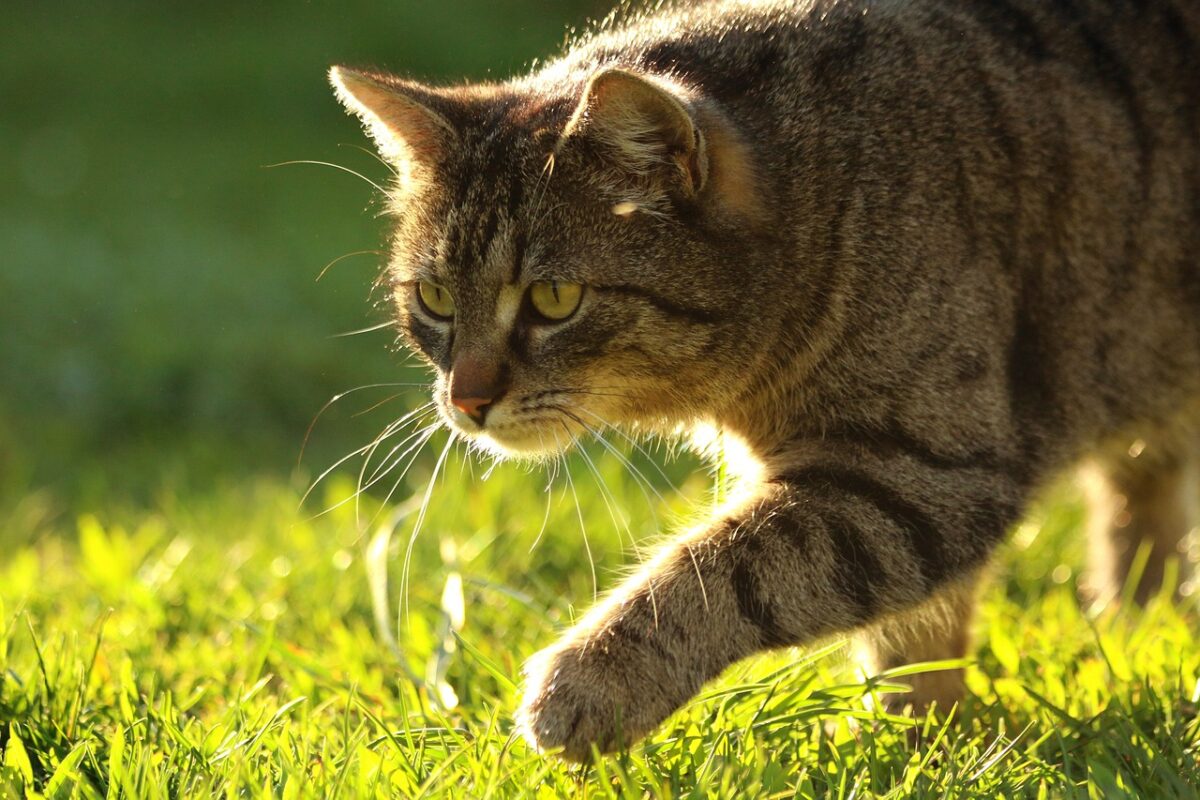
In short, cats and dogs have built-in survival instincts that can clash; understanding this is the first step in helping them live peacefully.
How to Change the Chase Behavior
The good news? With patience and training, you can help a dog and cat learn to live calmly together. Here’s how.
- Start with Early Socialization – Puppies are most open to new experiences in the first four months of life. If you can introduce a puppy to a cat early, you have a better chance of building positive associations. Reward calm, friendly behavior with treats, praise, and attention for both the puppy and the cat.
- Teach the “Leave It” Command – Impulse control is key. Before introductions, make sure your dog knows and reliably follows a “leave it” command. This will help later when you need to redirect attention away from the cat or the cat’s food, toys, or litter box.
- Use Desensitization – Desensitization helps both animals adjust calmly to each other’s presence. Start by keeping the cat in a secure crate or high perch where they feel safe. Let the dog see and sniff from a distance, rewarding calm behavior. Gradually move the cat to ground level while maintaining barriers. Repeat short sessions until your dog shows less excitement and more calm curiosity.
- Never Force It – Never leave your dog and cat alone together to “figure it out.” That’s a recipe for fear, injury, or long-term tension. Always supervise, and make sure the cat has an easy escape route.
- Never allow chasing, even “just once,” as it reinforces the wrong behavior.
Final Tip: With consistent training and supervision, most dogs can learn to live peacefully with a cat, or at least leave them alone. Focus on creating a home where both pets feel safe, calm, and respected.
7 Tips on How To Get a Dog and Cat To Get Along
Dogs and cats can get along beautifully, but success doesn’t just happen by luck. A lot depends on how the owners manage the household, especially in the early days. With patience, preparation, and a little strategy, you can help your pets not only tolerate each other but even become friends.
Here are some key tips to help your dog and cat live happily under one roof:
1. Start With a Positive Introduction
First impressions matter. Make sure the first meeting is calm, slow, and carefully supervised. Set clear boundaries, use leashes or barriers, and let them approach each other at their own pace. Avoid forcing interactions.
2. Give Each Pet Its Own Space
Both cats and dogs can be territorial. Provide each pet with their own food bowls, water, beds, toys, and litter or potty areas. Also, make sure each has access to a safe, pet-free zone where they can retreat when they need alone time.
3. Focus on Basic Training
Well-trained pets are easier to manage and less likely to stress each other out. Teach your dog basic commands like “sit,” “stay,” and “leave it.” While kittens can’t learn obedience commands, older cats can be encouraged with positive reinforcement, routine, and environmental consistency.
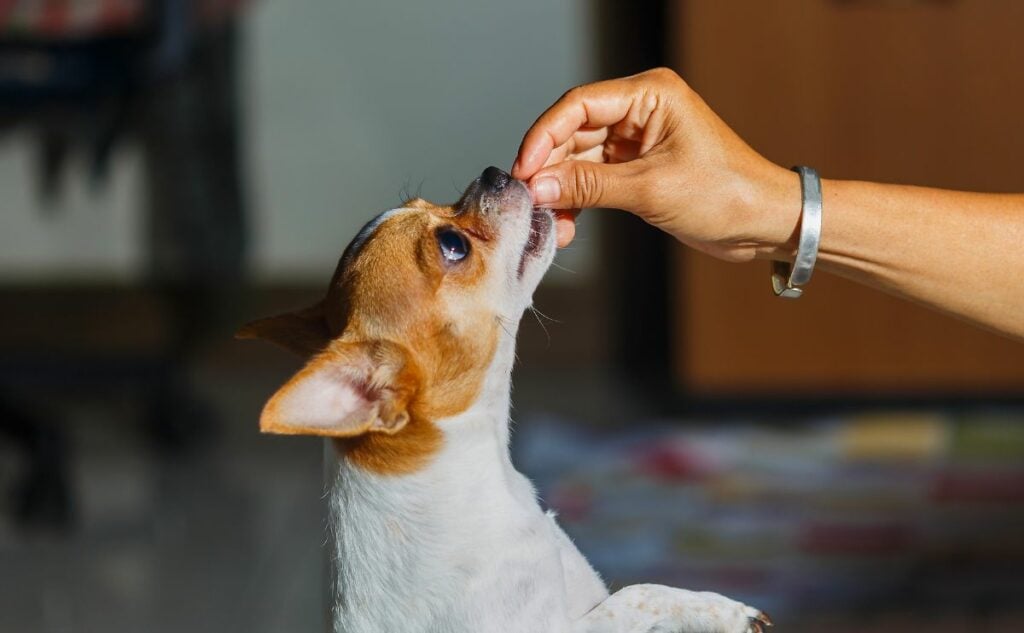
4. Be Patient With Older Pets
Older dogs and cats may need more time to adjust to a new housemate. Respect their need for space, avoid overwhelming them with too much too soon, and keep early interactions short and positive.
5. Manage Energy Levels
If your dog is hyper or high-strung, help them burn off energy before interactions. Extra exercise, playtime, or even a calming treat can help your dog approach the cat calmly instead of in full zoom mode.
6. Share Love and Attention Equally
Make sure no pet feels left out. Give treats, praise, and playtime fairly, so neither pet feels replaced or ignored. Uneven attention can create jealousy and lead to acting out.
7. Go Slow And Stay Consistent
Building a peaceful multi-pet household is a marathon, not a sprint. Expect ups and downs, be consistent in your approach, and always supervise interactions until you’re confident both pets are safe and relaxed together.
Watch For Warning Signs
If either is showing tense body language, give them a break and take them to separate rooms. You don’t want to force either into a situation that could get one of them hurt. You want to set your pets up for success. Until the animals seem relaxed around one another, you should not let them loose at the same time.
- If the dog becomes aggressive toward the cat and chases, pins, or picks up the cat, you should proceed with caution.
- If your dog growls, lunges, or barks obsessively at the cat, your dog may not be a “cat person.”
- If the cat growls, swats at, runs away from, or hides from the dog, your cat may not be a “dog person.”
If your dog is showing aggression towards your cat, you are not helpless. Find out how to stop dog aggression towards cats. And if all else fails, we recommend using a professional trainer to help.
6 Cat-Friendly Dog Breeds: Who’s Most Likely to Get Along?
If you’re thinking of buying a puppy or adopting a dog from a shelter and already have a cat, you might wonder if there are any dog breeds that tend to do well with feline companions.

While every dog has its own personality, the breeds below are generally known for being cat-friendly.
- Beagle – A small hound bred for hunting hares and rabbits, the beagle surprisingly gets along well with cats indoors. Things to note: Beagles can be challenging to train and are known for howling, which could be an issue with neighbors. Also, their strong hunting instincts might make outdoor time with the cat less peaceful.
- Bichon Frisé – A happy, sociable little dog that typically treats your cat like part of the family. Playful and cuddly, the Bichon loves attention. Heads-up: If your cat prefers quiet or alone time, you may need to separate them occasionally to give your cat a break.
- Golden Retriever – A family favorite for good reason, Golden Retrievers are patient, gentle, and tolerant of other pets, including cats. Bonus: They are highly trainable and make wonderful companions for multi-pet households.
- Maltese – Calm, laid-back, and generally uninterested in bothering the cat, the Maltese is happy to lounge and watch the world go by. This breed works well for homes with senior cats but is also tolerant of playful kittens.
- Pomeranian – Small, fluffy, and full of personality, Pomeranians are affectionate and confident, often happy to share your lap with the cat. Keep in mind: Their thick coat requires frequent grooming, which may add extra time to your pet care routine.
- Cavalier King Charles Spaniel – A gentle, quiet breed that loves snuggling with both humans and other pets. Cavaliers are easy to train, generally obedient, and don’t require heavy grooming.
They are usually tolerant and make a peaceful addition to a cat household.
Dog Breeds That Are Often a Challenge with Cats
Some breeds have natural instincts that make peaceful cohabitation with cats difficult. While exceptions exist, it’s smart to approach these combinations carefully.

Hunting Breeds
- Wolfhound, Deerhound, Samoyed, Alaskan Malamute, Norwegian Elkhound, Siberian Husky
- Bred to hunt large prey, these dogs often see small, fast-moving animals as targets.
- Even indoors, they may be too intense for a calm cat household.
Terriers
- Jack Russell, Scottish Terrier, Bedlington Terrier, Fox Terrier, Schnauzer, Rat Terrier
- Bred to dig out and kill vermin, and they’re very good at it.
- Reported cat chasers, even with training, find that their instincts can be hard to overcome.
Sighthounds
- Whippet, Greyhound, Lurcher, Italian Greyhound, Saluki, Afghan Hound, Borzoi
- Likely to chase anything that moves fast.
- A running cat can trigger instant pursuit.
Herding Dogs
- Border Collie, Australian Shepherd, Bearded Collie, Belgian Sheepdog, Welsh Corgi, Collie, German Shepherd, Old English Sheepdog
- Less likely to hunt, more likely to herd, but your cat won’t appreciate it.
- Can cause stress or fear by trying to “manage” the cat’s movements.
Introducing Your Dog to Others: Dogs, Kids, and New Family Members
Introducing your dog to other pets or children can feel just as nerve-wracking as introducing them to a cat, but with the right approach, you can help everyone start off on the right paw. For dog-to-dog introductions, it’s best to meet on neutral ground, like a park or sidewalk, with both dogs on relaxed leashes. Watch their body language carefully and keep first meetings short and positive.
When introducing your dog to a child, always supervise closely and teach kids how to gently approach and respect the dog’s space. Let your dog calmly investigate, and reward them for gentle, relaxed behavior.
To help monitor new interactions when you’re away, consider using a pet camera like the Furbo 360, which allows you to check in and keep an eye on your household. For more tips, explore our other articles on introducing dogs to babies, children, and new dogs. Remember: every good relationship starts with patience, supervision, and care.
Tell Us: How Did You Introduce Your Dog and Cat?
Have you introduced a dog and a cat? What worked, what surprised you, and what tips would you share with other pet owners? Drop your stories, questions, and advice in the comments below; your experience could help another reader build a happier, more peaceful multi-pet home. Let’s learn from each other!
